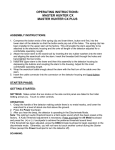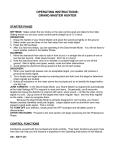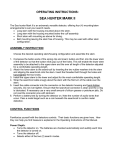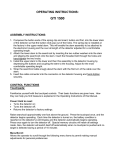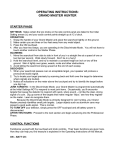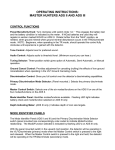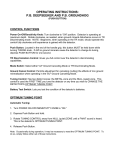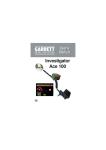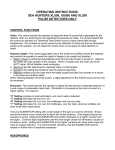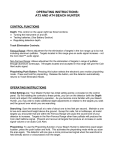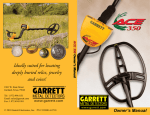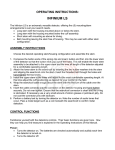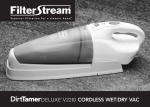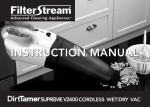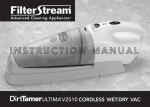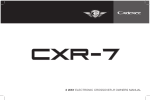Download OPERATING INSTRUCTIONS:
Transcript
OPERATING INSTRUCTIONS: BFO Detectors Introductory note: Beat Frequency Oscillators (BFO’s) have not been produced in many years and instruction manuals for most BFO detectors are no longer available. This Instruction Manual is produced and offered as a Generic BFO Manual to provide guidance and assistance to those seeking information on these detectors. Some of this information will not apply to the detector you have, but we hope you will take a moment or two to determine the features present on your detector and overlook the data provided which does not apply. ASSEMBLY INSTRUCTIONS 1. Insert the Lower stem into the searchcoil brackets. Install the Bolt and washers and Hand tighten the wingnut. Use no tools. 2. Depress the lower stem spring clip and slide the upper metal stem onto the lower stem to the desired length. 3. Depress the upper stem spring clips and attach this assembly to the detector housing. 4. Wrap the searchcoil cable snugly about the stem with the first turn of the cable over the stem 5. Insert the cable connector into the connector on the detector housing and hand-tighten securely. 6. The detector is now ready for use. CONTROL FUNCTIONS Familiarize yourself with the detectors controls. Their basic functions are given here. How they can help you find treasure is explained in the Operating Instructions of this Manual. ON-OFF VOLUME CONTROL: • Turns the detector on; • Turns the detector off; • Regulates the sound level when rotated clockwise. TUNING KNOB: There are three (3) distinct audio zones, from left to right. The METAL ZONE, the NULL, the MINERAL ZONE. Rotate the tuning control knob in both directions until two (2) distinct areas of sound has been heard, these are the Metal and Mineral zones. Rotate the knob slowly until the Null zone produces the lowest sound level between these two zones. Starting at the Null point rotate toward the Metal zone until the individual beats or “putt-putts” blend into a smooth, but slow motorboat sound. This is the optimum operating point. METER CONTROL KNOB: (If so equipped) This control permits adjustment of the meter pointer. After tuning on the detector turn this control until the pointer is just to the right of the “BAD ARROW” on the meter face. The meter pointer increases (deflects to the right) when good targets are located based on the setting of the discrimination control, and decreases (deflects to the left) when bad targets are passed over, again based on the setting of the discrimination control. BATTERY TEST SWITCH: After brief operation check the battery circuits. If the meter registers that the batteries are bad, replace them. Using the detector for a few moments will allow any accumulated battery surface charge to be used and the true battery condition is reported. SELECTOR KNOB: (If equipped with a discrimination circuit) Rotate the knob counter-clockwise to the position marked Standard BFO operation. Rotation of the knob clockwise from this point switches the detector into its Discrimination operation. COIL SELECTOR SWITCH: (If so equipped) If the detector has Dual Coil operating capabilities this switch allows the selection of the coil to be used. STANDARD NON-DISCRIMINATING BFO OPERATION • • • • Turn VOLUME CONTROL knob until sound is at the desired level. Rotate the SELECTOR knob counter-clockwise to the Standard BFO position. This is a true BFO Metal/Mineral Non-Discriminating operating mode. Select the coil size to be used by use of the Coil Selector Switch. All single coils operate in the “Large” position. Locate NULL zone of the tuning control. Rotate the TUNING CONTROL from NULL toward Metal until the smooth motorboat sound is achieved. Pass a metal object across the searchcoil, the sound will increase. If it decreases the detector has been tuned into the Mineral zone. Lower the searchcoil to within two to four inches of the surface. If the sound level changes, retune as above with the coil height being maintained at this height level. DISCRIMINATING BFO OPERATION • • • Select searchcoil size to be used by the COIL SELECTOR Switch. Adjust the VOLUME control to the desired sound level. Rotate the SELECTOR knob clockwise to the desired discrimination position. Lower the searchcoil to the operating height of two to four inches above the surface. Tune the detector in the METAL mode. The detector will not discriminate properly if the detector is tuned into the MINERAL mode. Bench Testing: This enables you to understand more fully the operation of the detector in the discriminate operating modes. Perform these tests with the searchcoil several feet away from any metallic object or surface. • Rotate the discrimination control fully counterclockwise. Set the Selector Control switch to the Standard BFO position. Pass selected targets past the searchcoil and notice that all targets give an audio response. This is true non-discriminating operation. You may also wish to test various rocks and ore samples at this position. • • • • Rotate the Discrimination control clockwise, re-tune and repeat the test. Some items will now give no audio response or perhaps a decrease in audio. Notice that the meter pointer increases or decreases as the audio response increases. These two functions operate in parallel with each other. Continue this test with various targets at higher discriminate settings and note where the trash items are no longer discovered. Never rotate the Discrimination control any farther clockwise than necessary to eliminate targets you do not wish to detect. Searching: Scan the searchcoil at a speed of about one to two feet per second, at a distance from the ground of about two to four inches. An audio increase will indicate the presence of metal beneath the coil. (If in the discriminate mode, only accepted targets will give an audio response). Pinpointing and Target Recovery: When the detector locates a target you must recover it to see what has been found. Pinpoint the target by making an imaginary “X” over the target. Where the loudest sound is, the target will be beneath the searchcoil. The final step is recovery and digging is usually involved. Always make as small a hole as possible and always fill your holes when the target has been recovered. Batteries: The BFO detector requires three (3) 9-volt batteries. When replacements are required use only high quality carbon, alkaline or rechargeable batteries. Battery Replacement: The batteries are located inside the electronic housing at the rear of the chassis. To access the batteries, loosen the two screws holding the battery panel in place. Carefully remove the panel and withdraw the battery tray from the detector. Remove the old batteries and install the new ones. Be sure to observe the proper polarity of the batteries when installing the new batteries. Reassemble making certain that all parts fit snugly, but do not force the parts together. PROFESSIONAL PHASE COIN HUNTING: After studying this Owner’s Manual very carefully, you will be able to perform more tasks with the detector and complete them more easily. The following tips represent the experience of a professional with the detectors. Deep coin hunting: For maximum depth and to avoid missing a small or very old coin, search in the Standard BFO mode. This will prevent missing an especially old coin that is so oxidized that it will be rejected by any discrimination. Hunting in trashy areas: Use of a smaller searchcoil can aid tremendously in the search for coins in areas with large accumulations of metal trash. Although any size searchcoil will perform in this arena, a small searchcoil will produce the best results. CACHE & RELIC HUNTING: Operating in the Standard BFO mode. Scan the searchcoil approximately two to four inches above the ground (depending on ground conditions) to eliminate erratic responses from ground minerals and small bits of metal. You will have super sensitivity and detect all targets dime-sized and larger. Caches and relics previously missed or overlooked will now be detected easily. ELECTRONIC PROSPECTING: Even though the BFO is a universal detector, it is excellent for prospecting and the ability to locate magnetic Black Sand deposits. Nugget Hunting: Use the larger of your searchcoils. Tune the detector into the METAL mode with a moderate to slow motorboating sound. This condition makes detection of small nuggets easier since detectors that adjusted to a slightly more rapid sound have a tendency to overlook the smaller nuggets. Searchcoil sizes will differ according to the area being searched. If the search area is in a dry wash or among large rocks that restrict the use of a large coil, change to the smaller size. When working in areas that have already been searched, your best option may be to change to a larger searchcoil. Extremely small nuggets may be missed with the larger coils, but the increased depth and sensitivity will permit you to detect deep nuggets that may have been previously missed. Professional nugget hunters know that one nugget of decent size is better than hundreds of microscopic ones. OPERATING RECOMMENDATIONS As you operate and use your Garrett detector, you will quickly grow more proficient in its use. It is recommended that you build your own test plot. Bury several items, including a nail, a piece of foil, a pulltab, a bottlecap and several coins at depths of about two to eight inches and a foot apart. Clearly mark the location where each article is buried. Practice scanning the targets while listening to and studying the detection signals. Remember that newly buried objects, especially coins, will be somewhat more difficult to detect than items that have been buried for some time. This is primarily a metallurgical phenomenon. Experiment with the various operating modes to see how your detector responds. Practice trying to pinpoint and locate targets precisely. When scanning, do not hurry. Scan the searchcoil at a speed of about one to two feet per second. Keep the searchcoil flat and level to the ground. Move it back and forth slowly and steadily while you walk at a pace that is comfortable. Be methodical. Do not skip any areas. Wear headphones for greater sound perception and concentrate on your scanning. After you have operated your detector for only a short time, you will be surprised at how proficient you have become in its use. Do not expect to achieve the greatest accuracy and success, however, until you have operated the detector for at least 100 hours or more. Good hunting! MAINTENANCE Always remember that your Garrett detector is a sensitive electronic instrument. It is built to withstand rugged treatment in the outdoors, but you should always handle the detector as carefully as possible. Try to avoid temperature extremes as much as possible, such as storing the detector in an automobile trunk during hot summer months or outdoors in sub-freezing weather. Keep your detector clean. Always wipe the housing after use, and wash the coil when necessary. Protect your instrument from dust and sand as much as possible. Your searchcoil is submersible. The control housing is not! Never submerge the control housing and always protect it from heavy mist, rain or blowing surf. Disassemble the stem and wipe it clean after use in sandy areas. When storing longer that about one month, remove batteries from the detector. REPAIR SERVICE In case of difficulty, read this Owner’s Manual again thoroughly to make certain your detector is not inoperable needlessly. Your dealer may also be able to offer advice. BFO detectors may not be repairable. Always check with the factory before sending the detector back. When your detector must be returned to the factory for service, always include a letter that describes its problem as fully as possible. Before you return your detector to the Garrett factory, make certain: You have read this Owner’s Manual carefully You have checked batteries, switches and connectors. (Check batteries especially closely. They are the most common cause of detector “failure”.) You have checked with your dealer, particularly if you are not familiar with this type of metal detector. You have included a note with the detector describing the problems you are encountering with this detector and conditions under which they occur. Make certain to include your name, address and a phone number where you can be contacted between 8:30 a.m. and 4 p.m., Central Time. You have carefully packed the detector in its original shipping carton or other suitable box. Make certain that proper insulation or packing material is used to keep all parts secure. Do not ship stems or headphones unless they are part of the problem. Be certain to return all coils, unless the problem is mechanical. Ship to Garrett Metal Detectors, 1881 W. State St., Garland, TX 75042. You can call Garrett’s Customer Service Department (972-494-6151) if you have further questions. Please allow approximately one week for Garrett technicians to examine and repair your detector after they receive it, plus another week for return shipping to you. All equipment will be returned UPS or parcel post unless written authorization is given by you to ship collect by air parcel post, UPS Blue (air) or air freight. MIND YOUR MANNERS Filling holes and obeying no trespassing signs are but two requirements of a dedicated metal detector hobbyist. A sincere request that Charles Garrett makes to every user of one of his detectors is that each place searched be left in a better condition than it was found. Thousands of individuals and organizations have adopted this formal Metal Detector Operators Code of Ethics: I will respect private and public property, all historical and archaeological sites and will do no metal detecting on these lands without proper permission. I will keep informed on and obey all laws, regulations and rules governing federal, state and local public lands. I will aid law enforcement officials whenever possible. I will cause no willful damage to property of any kind, including fence, signs and buildings and will always fill holes I dig. I will not destroy property, buildings or the remains of ghost towns and other deserted structures. I will not leave litter or uncovered items lying around. I will carry all trash and dug targets with me when I leave each search area. I will observe the Golden Rule, using good outdoor manners and conducting myself at all times in a manner which will add to the stature and public image of all people engaged in the field of metal detection. WARNING! Any metal detector may discover underground power lines; explosives or other items which when struck could cause personal injury. When searching for treasure with your BFO, observe these precautions: Do not hunt in an area where you believe there may be shallowly buried underground electric lines or pipes. Do not hunt in a military zone where bombs or other explosives may be buried. Avoid striking any line known to be or suspected to be carrying electrical power. Do not disturb any pipeline, particularly if it could be carrying flammable gas or liquid. Use reasonable caution in digging toward any target, particularly in areas where you are uncertain of underground conditions. PATENT PROTECTION: Proof of Garrett’s excellence is the recognition given them by the following United States patents: 4,709,213; 4,488,115; 4,700,139; 4,398,104; 4,423,377; 4,303,879; 4,334,191; 3,662,255; 4,162,969; 4,334,192; 5,148,151; 5,138,262; 5,721,489; 5,786,696; 5,969,528; Design 274,704 and 297,221; Design 333,990; G.B. Design 2,011,852; Australia Design 111,674 and other patents pending.







